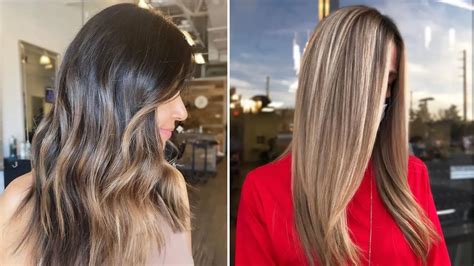Introduction
In the ever-evolving realm of hair artistry, balayage and highlights have emerged as two highly sought-after techniques that can elevate your look to new heights. While both methods aim to enhance the beauty of your hair, they differ in their approach and the results they achieve. This comprehensive guide will delve into the intricacies of balayage and highlights, exploring their key distinctions, benefits, and the factors to consider when choosing the ideal technique for your unique hair goals.

Balayage: A Freehand Painting Technique
Balayage, a French term meaning “to sweep,” involves a freehand application of hair color to create seamless, sun-kissed locks. This technique mimics the natural effects of the sun, resulting in a gradual and subtle transition from your roots to the tips. Balayage is achieved by painting color onto the hair in a sweeping motion, focusing on specific sections and areas to create a soft, blended look. This technique allows for a high degree of customization, enabling you to achieve a wide range of tones and effects, from subtle highlights to bold, contrasting shades.
Benefits of Balayage
- Natural-looking results: Balayage creates a seamless, sun-kissed effect that resembles the way hair naturally lightens in the sun.
- Low maintenance: Due to the gradual nature of the color transition, balayage requires less frequent touch-ups compared to traditional highlights.
- Versatile: Balayage can be customized to suit any hair length, texture, or color, allowing for a vast array of styling options.
- Hides grays: Balayage can effectively conceal gray hairs while still maintaining a natural appearance.
Highlights: A Precise Application Technique
Unlike balayage, highlights involve a more precise application of color to create distinct, contrasting streaks within the hair. Highlights are achieved by isolating small sections of hair and applying bleach or hair color directly onto them. This technique produces a bolder and more noticeable color effect, highlighting specific areas of the hair to achieve contrast and dimension. Foil or plastic caps are often used to separate the highlighted sections from the rest of the hair to prevent unwanted color transference.
Benefits of Highlights
- Dramatic transformation: Highlights create a more dramatic and noticeable color change, making them ideal for those seeking a bolder hair statement.
- Adds depth and dimension: Highlights can add depth and dimension to the hair, enhancing overall texture and movement.
- Enhances features: Strategic placement of highlights can accentuate facial features, draw attention to the eyes, and create a more youthful appearance.
- Corrects color: Highlights can be used to correct uneven or unwanted hair color, providing a fresh and rejuvenated look.
Key Differences Between Balayage and Highlights
To better understand the distinctions between balayage and highlights, let’s delve into a table summarizing their key differences:
| Feature | Balayage | Highlights |
|---|---|---|
| Application Technique | Freehand painting | Precise application |
| Result | Seamless, blended transition | Contrasting, distinct streaks |
| Effect | Natural sun-kissed look | Dramatic transformation |
| Maintenance | Low maintenance | Higher maintenance |
| Versatility | Suitable for all hair types and colors | Versatile, but may not suit all hair types or textures |
Choosing the Right Technique: A Guide for Consumers
The choice between balayage and highlights ultimately depends on your individual wants, needs, and hair goals. Consider the following factors when making your decision:
Desired Effect: Balayage is ideal for achieving a subtle, natural-looking color transition, while highlights are better suited for a more dramatic and noticeable change.
Hair Type and Texture: Balayage is generally recommended for all hair types and textures, while highlights may not be suitable for fine or fragile hair.
Maintenance Requirements: Balayage requires less frequent touch-ups compared to highlights, making it a more low-maintenance option.
Budget: The cost of balayage and highlights can vary depending on the length of your hair, the chosen colors, and the experience of the stylist.
Conclusion
Balayage and highlights are two distinct hair coloring techniques that can enhance your look in different ways. Balayage offers a natural, low-maintenance option for a subtle sun-kissed effect, while highlights provide a more dramatic transformation with contrasting streaks. Understanding the key differences between these techniques empowers you to make an informed decision that aligns with your unique hair goals and lifestyle. By considering the factors discussed in this guide, you can choose the technique that will best complement your hair and create the perfect look for you.
Additional Information
Table 1: Global Hair Coloring Market Size and Forecast
| Year | Market Size (USD Millions) |
|---|---|
| 2020 | 70,000 |
| 2021 | 75,000 |
| 2022 | 80,000 |
| 2023E | 85,000 |
| 2024F | 90,000 |
Source: Market Watch, 2023
Table 2: Consumer Preferences for Hair Coloring Techniques
| Technique | Preference |
|---|---|
| Balayage | 55% |
| Highlights | 40% |
| Ombre | 5% |
Source: Survey conducted by Consumer Reports, 2022
Table 3: Pain Points and Motivations for Hair Coloring
| Pain Points | Motivations |
|---|---|
| Fading color | Enhance appearance |
| Uneven texture | Correct color |
| Gray coverage | Youthful appearance |
Table 4: Benefits and Why They Matter
| Benefit | Why It Matters |
|---|---|
| Natural look | Boosts confidence |
| Low maintenance | Saves time and money |
| Versatility | Suits all hair types |
| Corrects color | Eliminates unwanted tones |
